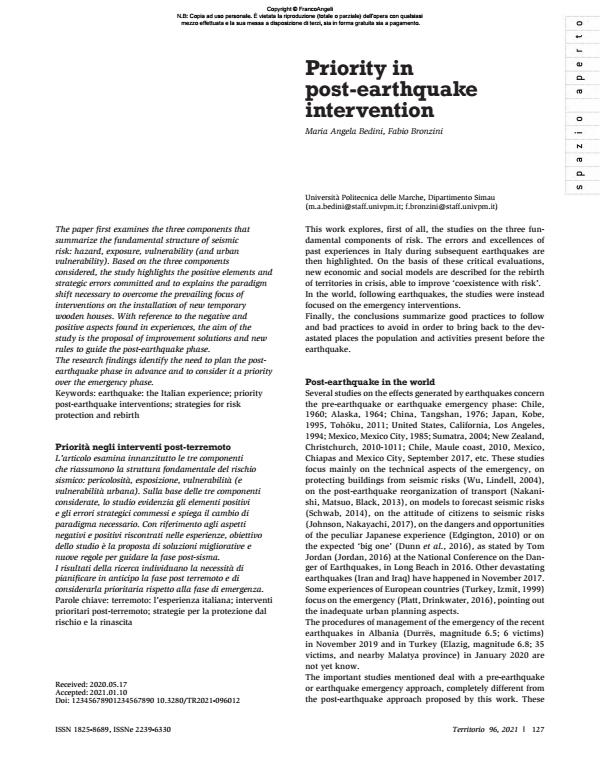Priority in post-earthquake intervention
Titolo Rivista TERRITORIO
Autori/Curatori Maria Angela Bedini, Fabio Bronzini
Anno di pubblicazione 2021 Fascicolo 2021/96
Lingua Inglese Numero pagine 10 P. 127-136 Dimensione file 963 KB
DOI 10.3280/TR2021-096012
Il DOI è il codice a barre della proprietà intellettuale: per saperne di più
clicca qui
Qui sotto puoi vedere in anteprima la prima pagina di questo articolo.
Se questo articolo ti interessa, lo puoi acquistare (e scaricare in formato pdf) seguendo le facili indicazioni per acquistare il download credit. Acquista Download Credits per scaricare questo Articolo in formato PDF

FrancoAngeli è membro della Publishers International Linking Association, Inc (PILA)associazione indipendente e non profit per facilitare (attraverso i servizi tecnologici implementati da CrossRef.org) l’accesso degli studiosi ai contenuti digitali nelle pubblicazioni professionali e scientifiche
The paper first examines the three components that summarize the fundamental structure of seismic risk: hazard, exposure, vulnerability (and urban vulnerability). Based on the three components considered, the study highlights the positive elements and strategic errors committed and to explains the paradigm shift necessary to overcome the prevailing focus of interventions on the installation of new temporary wooden houses. With reference to the negative and positive aspects found in experiences, the aim of the study is the proposal of improvement solutions and new rules to guide the post-earthquake phase. The research findings identify the need to plan the postearthquake phase in advance and to consider it a priority over the emergency phase.
L’articolo esamina innanzitutto le tre componenti che riassumono la struttura fondamentale del rischio sismico: pericolosità, esposizione, vulnerabilità (e vulnerabilità urbana). Sulla base delle tre componenti considerate, lo studio evidenzia gli elementi positivi e gli errori strategici commessi e spiega il cambio di paradigma necessario. Con riferimento agli aspetti negativi e positivi riscontrati nelle esperienze, obiettivo dello studio è la proposta di soluzioni migliorative e nuove regole per guidare la fase post-sisma. I risultati della ricerca individuano la necessità di pianificare in anticipo la fase post terremoto e di considerarla prioritaria rispetto alla fase di emergenza.
Parole chiave:terremoto: l’esperienza italiana; interventi prioritari post-terremoto; strategie per la protezione dal rischio e la rinascita
- New Metropolitan Perspectives Maria Angela Bedini, Fabio Bronzini, pp.594 (ISBN:978-3-031-06824-9)
- Beyond the limits of the city. Ten Commandments for protection against pandemic risk Maria Angela Bedini, Fabio Bronzini, in TERRITORIO 101/2023 pp.155
DOI: 10.3280/TR2022-101018
Maria Angela Bedini, Fabio Bronzini, Priority in post-earthquake intervention in "TERRITORIO" 96/2021, pp 127-136, DOI: 10.3280/TR2021-096012